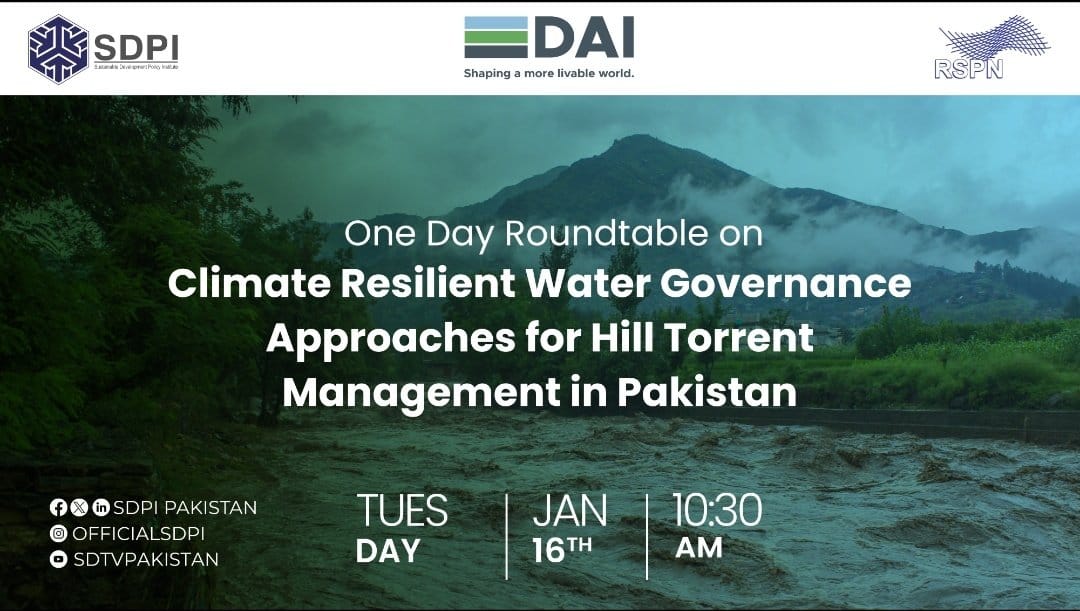ISLAMABAD, Jan 16 (APP):Executive Director of Sustainable Development Policy Institute (SDPI), Dr Abid Qaiyum Suleri on Tuesday said
that the blockade of waterways due to illegal construction after flooding in hill torrent prone areas was inflicting heavy losses to infrastructure, livelihoods and human lives.
He was speaking at a one-day roundtable titled: “Climate Resilient Water Governance Approaches for Hill Torrent Management in Pakistan”, organized by Sustainable Development Policy Institute (SDPI) in collaboration
with Pakistan Rural Support Programmes Network (RSPN), and DAI.
The roundtable aimed to stir result-oriented dialogue among the public, private sector, and civil society stakeholders to mull over hill torrents’ floodwater governance issue. It incorporated community perspectives from representatives, who joined from hill torrent affected areas from D.I. Khan, Rajanpur, Swat apart from Sindh and Balochistan.
Dr Suleri said
that popul
ation explosion, deforestation, and urbanis
ation are the major causes of fading away of water management systems and infrastructure. The temperature systems of La Nina and El Nino effects and weather change had already increased precipit
ation to an erratic level, he added.
“SDPI’s climate change and water management teams are closely working on these areas, and it’s impacts
that were above normal on girls, women, children and others,” he said.
Mr Ahmed Kamal, Chairman of Federal Flood Commission (FFC), said Pakistan has been facing the worst flooding due to reverse monsoon activity as monsoon used to start from Tarbella, but in 2022 the low pressure was built up in Sindh province
that caused abnormal rains in Sindh and Balochistan.
The sporadic flooding in September 2022 in Swat and Kabul river also caused flooding in the areas, he said, adding
that in Koh-e-Suleiman Range, Rajanpur and Dera Ghazi Khan areas hosted 11 hill torrents
that caused havoc.
He noted
that the total water storage capacity of the country was 3.43 million acres feet
that comprised three dams, i.e. Tarbela, Chashma, and Mangla. He underlined
that the country’s priority was low towards mitigating natural disasters
that needs to be addressed.
In 2022, he said monsoon season not only prompted the public sector but also the civil society, community and private sector
at large to better manage the hill torrents water.
“More than 6,000 bridges have been established in the hill torrents’ prone areas. However, it was ill planned, and poorly implemented as the water flow overtopped the capacity of built structures,” he said and stressed the need to establish public, private sector and community nexus in this regard.
Darren Saywell, Senior Lead Specialist, Water Security, Sanit
ation and Hygiene (WSSH) at DAI Global, said the context
of the discussion was important as it was based on the improvement in water management, climate resilience, and Green Pakistan movement
that is crucial for the country’s climate resilience.
“Today’s roundtable will help align our assets to manage the water issues and learn best practices from the partners and community stakeholders. There is a tremendous experience in Pakistan on the issues of water and disaster management,” he added.
Saywell said the DAI globally would add the international experience applicable to the public-private and civil society organisations (CSOs) level interventions.
He said
that the Pakistan case study based on its experiences is important particularly in water governance. However, nothing changes unless there are incentives to adopt
that change and therefore the incentives for hill torrents management needs to be identified.
Bilal Anwar, Chief Executive Officer, National Disaster Risk Management Fund (NDRMF), said the 2022 floods were a mammoth disaster and the entire efforts of the Fund in reconstruction were focussed on riverine floods and hill torrents management.
Pakistan, he said, largely faced the riverine floods due to unique river systems and Indus Basin topography. The 2022 floods were an awakening call for the country whereas the risk modelling and assessment was focussed on riverine floods, he said. Around 1,204 water conserv
ation sites existed in the flood-hit areas, if preserved, could have become a huge source of water for the country and help manage the water crisis.
“The large bulk of work was not done on those sites
that resulted in 2022 floods devastation,” he said. Mr Anwer said inclusion of hill torrents in our national catastrophic policy discourse was critical, therefore, the NDRMF would roll out
that model soon
that will guide the endeavours of policymakers.
“The value of working in collabor
ation and
with institutions is important and essential feature of climate adaptation. The whole climate adapt
ation work is linked to riverine water management in Pakistan,” he added.
Ms Zainab Naeem, SDPI’s Associate Research Fellow, highlighted the existing areas being affected by hill torrents in Pakistan and the causes of flooding along the hill torrents.
CEO, Pakistan RSPN, Shandana Humayun said there was a work going on ground in the realm of flood resilience and disaster management but it required collabor
ation and partnerships to galvanize its impact and benefits for the local communities.
“It is very critical to bring
that work at the community level through collaborations as partnerships are needed along
with such forums where communities can sit
with the government in the issues,” she added.
Arsalan Ali Faheem, the Country Director, DAI Pakistan, stated
that the existing water governance structure is under resourced and was never setup to face challenges of large-scale devast
ation due to floods.
“We need to gather realistic outputs and develop proposals which could support community led approaches for managing such challenges and also incorporate incentive based approaches for making inclusive and efficient decisions.”
He also stressed the need to develop a framework inclusive of four elements. i.e. community structure, financial resources, technical know-how, and decision-making power.
